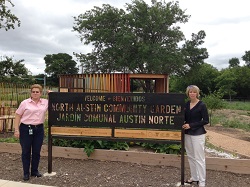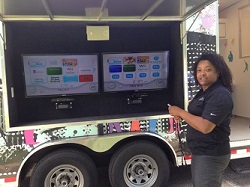NRPA’s Vice President of Urban and Government Affairs Kevin O’Hara continues his series of dispatches from urban park and recreation agencies. He recently spent time visiting some of the Lone Star State’s best and brightest parks and recreation facilities. In July, O’Hara regaled us with tales from his trip to Houston — here, he details a visit to Austin, one of Texas’ best-known and best-loved cities.
Upon landing at Austin–Bergstrom International Airport, you feel something special about Texas’ self-described “weird” city. Indie singer-songwriters serenade airport travelers as they trudge to and from their gates while local bookstores and restaurants nourish visitors’ weary bodies and minds. Once you arrive downtown, you quickly realize that music, art, parks and public space are central to this community’s identity. During the course of a single action-packed day in early June, Austin Parks and Recreation Department (PARD) Director Sara Hensley and Assistant Director Kimberly McNeeley showed me even more reasons to be excited about Austin.
Downtown Austin is centered on Lady Bird Lake — formerly known as Town Lake — which was created in 1960 by damming the Colorado River. A 10.1-mile PARD trail runs the circumference of the lake, where joggers and bikers pass by kayakers, paddleboarders and swimmers enjoying the water. Earlier this summer, PARD opened up a spectacular boardwalk extension of the trail, allowing users east and west of I-35 to have uninterrupted access to the lake.
 Even beyond the signature downtown recreational spaces, including Barton Springs Pool and Zilker Metropolitan Park, Austinites are never far from a park and recreation facility. I saw how partnerships with the YMCA created a wonderful recreation center and community garden in North Austin, and the sparkling brand-new Bartholomew Pool, where — as if on cue — a resident pulled up and asked when the facility was opening (the next day), and effused about how excited her family was for this new neighborhood amenity.
Even beyond the signature downtown recreational spaces, including Barton Springs Pool and Zilker Metropolitan Park, Austinites are never far from a park and recreation facility. I saw how partnerships with the YMCA created a wonderful recreation center and community garden in North Austin, and the sparkling brand-new Bartholomew Pool, where — as if on cue — a resident pulled up and asked when the facility was opening (the next day), and effused about how excited her family was for this new neighborhood amenity.
Holistic Methods for Supporting Communities
Rosewood Recreation Center serves a predominantly low-income community in East Austin. The dedicated staff there gave me an overview of the innovative ways they engage with at-risk youth. Leading a city-wide effort, this team emphasizes a holistic approach that ties their outreach and programming to 40 youth-development assets that help craft kids into successful and functional adults. Staff is trained on how to tie those goals to programming at Rosewood. This team and this department have been instrumental in promoting shared language for youth development providers and were recently asked by the Wallace Foundation to present their model at a youth development concert. Contact Youth and Teens Programs Supervisor Veronica Delgado to learn more about those initiatives.
The TCTA (Totally Cool, Totally Art) program offers free community-based arts education for teenagers who may not otherwise have such opportunities. TCTA is much more than just an arts and crafts program — it promotes a philosophy centered on the many benefits of arts education for teens. TCTA Program Coordinator — and fellow Minnesota Viking fan — Clint Hofmeister and his team teach art in a variety of media including blacksmithing, computer animation, filmmaking, printmaking, installation, conceptual art, portraiture and urban painting. (Maybe it’s something in Austin’s water — these kids come across as bona fide artists. Check out the video.)
The Roving Leaders outreach program teaches life skills and incorporates social-emotional learning to explore difficult topics teens encounter daily, such as violence and addiction. Youth are given a safe space to practice problemsolving and are encouraged to use critical thinking skills. Staff members serve as positive role models while guiding participants through activities, lessons and field trips designed to build character and present leadership opportunities. From hand delivering gifts via the Blue Santa Program to tree plantings and food-bank volunteerism, teens demonstrate leadership through civic engagement, community advocacy and service-learning projects. Youth participants are also provided chances to utilize technology as a mechanism for self-expression, a forum for advocacy and as a method of career and talent exploration. Part of Roving Leaders’ efforts includes a mobile gaming lounge/youth engagement magnet. With this custom-built vehicle, Delgado and her colleagues take their message to where the kids are, drawing them in with opportunities to test their Wii or Xbox skills, and giving PARD staff the opportunity to pitch afterschool, art-based or other programming.
problemsolving and are encouraged to use critical thinking skills. Staff members serve as positive role models while guiding participants through activities, lessons and field trips designed to build character and present leadership opportunities. From hand delivering gifts via the Blue Santa Program to tree plantings and food-bank volunteerism, teens demonstrate leadership through civic engagement, community advocacy and service-learning projects. Youth participants are also provided chances to utilize technology as a mechanism for self-expression, a forum for advocacy and as a method of career and talent exploration. Part of Roving Leaders’ efforts includes a mobile gaming lounge/youth engagement magnet. With this custom-built vehicle, Delgado and her colleagues take their message to where the kids are, drawing them in with opportunities to test their Wii or Xbox skills, and giving PARD staff the opportunity to pitch afterschool, art-based or other programming.
Knowing your audience is critical to making a sale, and these dedicated park and recreation professionals not only know their audience, they also know how to close a deal. Basing programming on “what kids want” goes a long way to giving these same kids what they need, which are the life skills that will prepare them for lifelong learning and success. From resume building to PowerPoint training and college visits, I saw examples of the how this PARD staff makes a difference in the lives of the young people in their neighborhood and beyond.
How does your agency tie outcomes to goals? Do you work with your youth in this way?
A visit to the A.B. Cantu Pan-American Recreation Center showed how seniors are engaged in programming through the design and creation of an accessible healing garden, featuring herbs and flowers planted and tended to by seniors from the neighborhood. In addition to having an amphitheater that celebrates the Tejano traditional music of the area, A.B. Cantu boasts PARD’s only boxing gym. It was here that I learned of the lengths staff goes to ensuring that the surrounding neighborhood is engaged in their programming. Using technology, A.B. Cantu staff increased the number of participants and tailored their programming to meet the needs of a rapidly changing community.
How does your agency use technology to increase citizen participation in your planning and programming? We know the senior population is increasing as a percentage of our national makeup— how are you going to meet the needs of this growing customer base?
The final stop in Austin was at Camacho Recreation Center. After about 2 minutes I was ready to enroll in the summer camp there. Camacho is on the east end of Lady Bird Lake, where kids have access to all that Austin has to offer. Whether it’s kayaking, canoeing, fishing or mountain biking (AWARD-winning mountain biking!), the staff at Camacho provide training and access to the outdoors that is unmatched by what I’ve seen during my brief tenure at NRPA.
Active outdoors sports are a great way to get kids active and connected to nature — what programming do you offer?
The intentionality of the work being done at PARD is remarkable. But, don’t take my word for it, go visit Hensley and her dedicated team and see for yourself. I know I’ll be back, as there is much more to learn from this team.
 Kevin O’Hara seen here during a jog on Austin’s Lady Bird/Town Lake trail is NRPA’s vice president of urban and government affairs.
Kevin O’Hara seen here during a jog on Austin’s Lady Bird/Town Lake trail is NRPA’s vice president of urban and government affairs.

